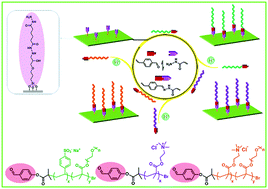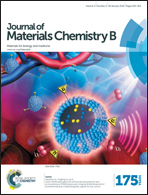Switching biological functionalities of biointerfaces via dynamic covalent bonds†
Abstract
The development of biointerfaces with switchable properties is of growing interest for fabricating advanced biomaterials since the adjustment of surface properties can be made on demand. Herein, we report a highly versatile approach for the preparation of a switchable biointerface through a dynamic covalent bond (DCB). The switchability can be achieved via the reversible attaching/detaching of aldehyde end-functionalized biomacromolecules onto/from an acylhydrazide anchored substrate surface. By applying the DCB protocol, three types of well-designed aldehyde end-functionalized biomacromolecules including aldehyde-poly(styrenesulfonate)-co-poly(ethylene glycol)methyl ether methacrylate (Ald-PSP, blood compatible), aldehyde-poly([2-(meth acryloyloxy)ethyl]trimethylammonium chloride) (Ald-PMT, antibacterial), and aldehyde-poly([2-(meth acryloyloxy)ethyl]trimethylammonium chloride-co-poly(ethylene glycol)methyl ether methacrylate) (Ald-PMP, combined antifouling and antibacterial) could be reversibly and alterably immobilized on the substrate surface by switching the pH conditions. As a result, we succeeded in altering the biointerface performances; excellent blood compatibility, antibacterial ability, or combined antifouling and antibacterial capabilities could be alterably achieved on the biointerface, which made the obtained material interfaces more adaptable and capable of satisfying different biofunctional requirements. Moreover, many other properties with specific biofunctions of interests can also be achieved via designing specific aldehyde-terminated molecules.


 Please wait while we load your content...
Please wait while we load your content...